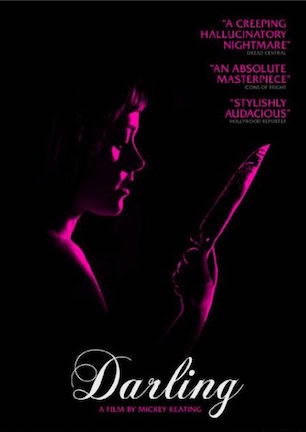Studio: Glass Eye Pix
Director: Mickey Keating
Writer: Mickey Keating
Producer: Mickey Keating, Jenn Wexler, Sean Fowler
Stars: Lauren Ashley Carter, Brian Morvant, Sean Young, Larry Fessenden, John Speredakos, Al-nisa Petty, Helen Rogers
Review Score:
Summary:
A young woman’s sanity unravels when she becomes the lonely caretaker of a New York City home with a haunted history.
Review:
Movie reviews often open on a summary of the story. Would if I could, although “Darling” barely has a story to speak of.
Sean Young stands still on her mark for the first of two brief bookend scenes. (She remains in place, so does the camera, for the mid-credits coda occurring days later wearing the same hair and earrings, but at least wardrobe swapped her dress.) Young fills a function not as a character, but as a catalyst giving context for a frame around the film’s pseudo-psychological portrait of a sullen sociopath in the making. Lauren Ashley Carter features as the titular woman hired by Young to take a Jack Torrance descent into madness by way of Roman Polanski’s “Apartment Trilogy” as the lonely caretaker in an old New York City home with a possibly haunted history.
"No one will notice we shot two separate scenes in one single setup."
Outside of that loose outline, you won’t find much more of a tangible narrative in “Darling.” Plot points equivalent to hand waves include a mysterious locked door at the end of a hallway, an entrancing inverted cross pendant, whispers of devil worship, black magic incantations scrawled into a wall, and a man believed to be someone other than he seems. All the earmarks are in play for suitably Satanic fright fare, though don’t expect the movie to make any rational sense out of the above on your behalf.
“Darling” is a minimalist mood piece playing best to an arthouse audience hypnotized by ambiguous artistry. Its elements are interpretive metaphors for the experimental exploration taken by Carter to create a character out of perhaps ten pages of dialogue, and by director Mickey Keating to smash cut and strobe effect his black and white visuals into an epileptic’s worst hallucinatory nightmare. In more than one instance, Carter stares into the lens with wide eyes while Keating adds Bernard Hermann-esque violin strains and it is up to the viewer to infer whatever is meant to be thought-provoking or terrifying about such audio/visual pairings.
It’s difficult to justify “Darling” as an effective character study intelligently or even imaginatively examined through stylistic invention when so much of that study and that style is limited to editing room experimentation. The film’s creativity relies excessively on sensory assaults of white-hot screaming faces flashing like a zoetrope as a means of establishing atmosphere. Without clear context or a discernible direction motivating the mood, these sight and sound jumbles melt into more of an MTV morass than they do into a menacing movie.
As in laboratory science, an experiment conducted in film should start from a hypothesis regarding what it aims to accomplish, or what it expects the end result will uncover. With that in mind, does “Darling” fulfill an explicit purpose by belaboring a montage of nighttime New York cityscapes, occupying a full two minutes with Lauren Ashley Carter scrubbing a tub using paper towels, or spending another two on applying makeup and dressing, for example? Some might think so. Others might simply sit through 78 minutes of lengthy static shots featuring banisters, dining room tables, or window lattices, and scenes of Carter lighting cigarettes, sipping a glass of water, or putting on mascara and have only an inclination to eye their watches with an impatient sigh.
“Darling” earns 2.5 out of five stars because, being familiar with the previous work of Keating and Carter, I believe they took artistic risks in daring to take “Darling” somewhere specific cinematically. Their film loses the other 2.5 stars because I’m unable to determine exactly where that is supposed to be.
For a more engaging, more traditional indie horror-thriller featuring Lauren Ashley Carter, Sean Young, and Larry Fessenden of “Darling,” as well as Sean Bridgers in meatier, fully formed roles, seek out “Jug Face” (review here). For a Mickey Keating movie describable with similar adjectives, look for “Pod” (review here).
Review Score: 50







If you want to see impossible amounts of blood explode crimson colors like the world’s worst version of a gender reveal, well, “Abigail” at least has that.